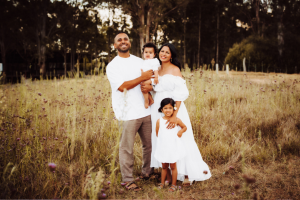What does the size of your family mean for your career? Three Australian families of different sizes share their stories and cast a light on the realities of juggling children and career.
One child
If you’re the proud parent of one adored offspring, it’s likely you’ve been quizzed by a well-intentioned aunt about your plans to provide a sibling. How do you answer if you plan to stop at one? Do you laugh it off and change the subject, or risk being judged for putting your career first? If the choice is in your hands to have one child or more, would you stop at one for the benefit of your career? And does the number of children you have actually make an impact?
According to The 13th Annual Statistical Report of The Household, Income and Labour Dynamics in Australia (HILDA) Survey, the share of parents in couple-families who both work full time is largest when there is only one child (27.3%). This share declines as the number of children in a family increases.^
So, what are the factors that make it less likely that both parents will remain in full time employment if they have more than one child?
It’s no surprise that adjusting to life after baby can be an enormous challenge, but many parents aren’t prepared for just how big the adjustment is or how long it takes, particularly at work.
When Elizabeth’s daughter was born in November 2017, she initially took off ten months from her job as a manager in a large consultancy. As someone that’s very career-focused, Elizabeth thought she would be itching to get back to work quickly.
“In fact I really enjoyed parental leave, and wasn’t comfortable leaving my daughter at such a young age,” recalls Elizabeth, “so I extended my leave to 14 months. By this time, I was ready to get back to work.”
However, the first challenge arose for Elizabeth and her partner when they could only secure two days of childcare. “This was problematic for me at work, as my manager didn’t think I could perform my role at my level at two days a week,” she says.
With the support of a nanny, Elizabeth and her partner agreed to take on a day of childcare each—meaning they would both work a four-day week. “For a short while, this was feasible,” says Elizabeth. “However, my partner runs his own business and, after about three months, was feeling stressed at trying to operate at 20% less capacity. We couldn’t afford the nanny for any more days. Despite our best efforts to manage childcare equitably, we agreed that he had to return to work full time. I remained at four days a week and luckily, we secured four days a week at the childcare centre (saying goodbye to our wonderful nanny). That one weekday at home is useful, though—it lets me catch up on some housework and cooking, as well as spend more time with my daughter.”
In contrast to life with two or more children, having one child can offer greater freedom and flexibility for working parents. Childcare and other financial burdens are generally lower when paying for one, and meeting the needs of one child—particularly when the parent-to-child ratio favours the grown-ups—in most cases leaves more time for work and other pursuits. This can mean easier integration of work and home life, and less stress for families.
“Overall, having one child hasn’t impacted my career trajectory. I have to work harder and smarter to achieve my personal and work objectives in condensed time, but having one child—and the break that that entailed—hasn’t significantly stalled my career. I think the greatest impact has been on my social life. We don’t party as much as we used to!”
Two children
According to the 2016 Census of Population and Housing, the ‘typical’ Australian is a 38-year-old female who is married and lives in a couple family with two children.^^ After the birth of her first child, she will spend about half as much time on housework as she did before children. Her time spent on housework will increase again after her second child is born.
So, why do the majority of Australian couple families with children stop at two? Is pursuit of career or perhaps the stress of juggling work and home life steering decision making for Australian parents?
Vittoria took one year’s leave from her role within the principal team at a high performing state secondary school after having each of her two sons, now seven years and 16 months. While career was one of many factors considered by Vittoria and husband Rob when making family planning decisions, it wasn’t the driving force.
“When I reflect on the last seven years, I can honestly say our decisions in relation to when to have children and how many to have, were not heavily influenced by my career,’ says Vittoria, who identifies three key reasons for this.
“Firstly, while my career is of high priority, the desire to have children was overwhelming, and at the times when we decided to have both our kids, this was our first priority.”
Support in employment and at home are also contributing factors, “I am fortunate to work for a principal who supports women in leadership and creates an environment where they are able to flourish in their career and have a family,” says Vittoria. “I never felt that my career aspirations would be in jeopardy at all by our decision to have children. The evidence lies in the fact that I was given a substantive assistant principal position while I was pregnant with my second child.”
In a role reversal of traditional breadwinner and homemaker stereotypes, Rob is full time homemaker and dad. While he has felt fulfilled by this challenging role, he also looks forward to focusing on career again when the time arrives.
While Rob and Vittoria have made the decision to have two children based on a feeling of completeness rather than career and the demands of children, theirs is a ‘typical’ Australian story where one parent in couple families will participate less in employment as the number of children increases.^
Three or more children
Having a large family with three or more children comes with its own challenges. More children generally implies greater financial burden, which may be eased by one or both parents spending more time in employment. Conversely, more children suggests more time is required for care, leaving parents to consider spending less time at work.
A 2011 Census of Population and Housing study suggests that three children is the tipping point for continuing to work post-baby, as employment rates of Australian mothers drop significantly (from 68% to 55%) after the birth of a third child. This is backed up by The HILDA Survey which makes the case that “overall, mothers’ employment participation is lower in large families than in one- and two- child families, suggesting that it is mainly mothers who accommodate the additional care time needed at the arrival of a third child.”^
But while many couple-families with three children report one parent, typically the mother, dropping out of the workforce at this point, the arrangement most common among parents of large couple-parent families is in fact a father who works full time and a mother part time (34.5%)^: an arrangement that suits Nicole and James, parents of three children aged seven years, five years and 10 months.
After leaving the workforce when her first two children were in nappies, Nicole relaunched her career, but later discovered she was pregnant with baby number three. “After our third child arrived, pursuing my career was a priority,” says Nicole. “Until that point I had taken on the lion’s share of housework and care, but if I was going to continue to work, I would need extra support.”
Nicole communicated her expectations to her husband, and sought the help of family and professional childcare. “My husband has some flexibility at work which has enabled him to help with school and kinder runs, and in emergencies. He has stepped up around the house and we now divide housework more evenly.
“Having a supportive employer has been fundamental. The ability to work flexibly and build up my hours as I transition back to the workplace after parental leave has made the adjustment possible.”
“Although my working hours have increased since having a third child, this has only been possible with better support networks and greater flexibility.”
The statistics are clear in illustrating that it is women who tend to withdraw from the workforce and take on a greater share of household duties, while men tend to withdraw from the housework and care, whilst maintaining paid employment to meet the financial burden. Whatever the arrangement, there’s no denying that more children equates to a greater workload in the home, more time spent on care, and greater financial burden for families. Something that needs to be considered when family planning.
Regardless of parental gender roles or number of children, any family can make it work by having the right support in both employment and the home. It’s about weighing up family priorities and needs.
Vittoria reflects, “A parent who wants a career and a family can in reality achieve both if those around them support and encourage them. I know in all situations, it may not be this simple. However, for me, I feel that I have been able to flourish in my career and be a mum to my two most treasured blessings.”
Written by the Circle In team.
^Wilkins, Roger and Inga Lass, (2018) The Household, Income and Labour Dynamics in Australia Survey: Selected Findings from Waves 1 to 16. Melbourne Institute: Applied Economic & Social Research, University of Melbourne.
^^The Australian Bureau of Statistics (ABS), Census reveals the ‘typical’ Australian, 2016 Census of Population and Housing.







